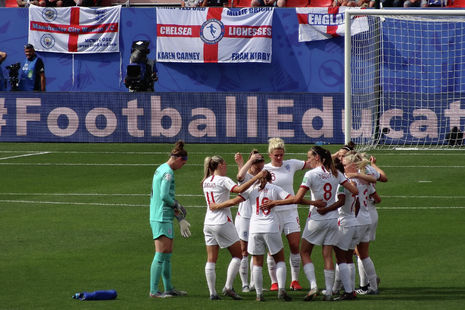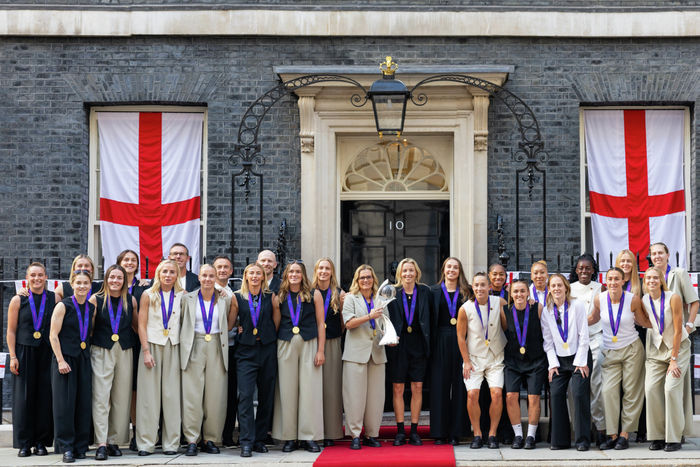Why it matters that 97% of the Lionesses are state-schoolers
Holly-Marie Greening places the Lionesses’ grassroots glory under the microscope

When England’s Lionesses lifted the UEFA Women’s Euro trophy this summer, they weren’t just defending a title – they were quietly making sporting history. 97% of the 23-player squad are state-school educated, having attended a range of comprehensives, grammar schools, or sixth-form colleges. Only goalkeeper Anna Moorhouse, an unused substitute for Hannah Hampton, came up exclusively through the private school system.
A statistic like this might make some ask why we should care about the educational backgrounds of footballers at all. If what matters is scoring goals – and more importantly, winning games – why should we care about which institution they sat their GCSEs in? While fans may want to boast of meritocracy within the sport, any talk of an even playing field demands an acknowledgement that performance on the pitch is undeniably skewed by privilege.
Football has long prided itself on having a more democratic reputation than many other British sports, where talent pipelines often funnel athletes directly from independent schools with elite facilities. Men’s rugby, rowing, and cricket remain rife with alumni hailing from private institutions, where coaching is specialist and competitive structures are deeply entrenched.
“Performance on the pitch is undeniably skewed by privilege”
A 2019 Sutton Trust report found that 43% of England men’s cricketers and 37% of men’s rugby internationals were privately educated. Men’s football appears to be the exception to this rule, with 15% of the 2024 England squad attending private schools, though this remains disproportionate: the privately educated make up just 7% of the British population as a whole.
Women’s football has developed largely outside of this paradigm, in part owing to its history of suppression. When the Football Association (FA) banned women playing on affiliated pitches in 1921, a ban not lifted until 1971, national infrastructure for girls’ football was almost nonexistent, and investment remained stalled until as late as the early 2000s. Subsequently, the introduction of the Girls’ England Talent Pathway in 2012 has been crucial in partnering schools and clubs around the country, to try and dismantle the system of exclusivity and independent schools that churns out so many elite athletes in other sports.
The importance of these accessibility initiatives cannot be understated. As many Lionesses have been quick to point out, their journey to the Euros began with local clubs, council pitches, and school PE teachers. Not flashy sports complexes.
Lucy Bronze, then playing for England Under-17s, almost couldn’t take her GCSE PE assessment in football until her mother, a maths teacher, convinced the boys’ coach to let her participate. Beth Mead, from a small village in North Yorkshire, recalls playing football in a local field as the only girl in a volunteer-run Saturday program. She later captained the boys’ team to a local cup win. Alessia Russo and Ella Toone have been friends since school, having grown up together in youth football camps which took them all the way to winning trophies for England. The anecdotes abound.
“Talent can and will thrive when the playing fields are truly level”
A majority state-schooled national football team sends a powerful message: elite sport doesn’t have to be the playground of the privileged. In a country where access to sporting excellence is still often constrained by your postcode or household income, their success is proof that talent can and will thrive when the playing fields are truly level.
More than that, a national victory “brought to you by state schoolers,” as a recent Instagram post from the 93% club put it, serves as a stark reminder of the Lioness’ lasting legacy. After becoming European champions in 2022, the team penned an open letter to the government which demanded equal access to football for girls in school. Westminster pledged to make equal access a requirement, as well as publishing what each school offers. Now, just two years later, a team of overwhelmingly state-educated players have lifted another European trophy.
Winning the tournament in Basel will no doubt provide inspiration for a whole new generation of girls to pick up a ball, in the hopes of one day wearing a jersey for England. But the lesson from this squad’s make-up is clear: inspiration means nothing without access. Schools need pitches and coaching, clubs need secure long-term funding, and pathways to play at international level must remain open to those from less affluent backgrounds.
These players are more than mere statistics. They are living proof that trophy-winning talent can be born and bred entirely from the state education system. The difficulty now lies in maintaining women’s football as the rule, not the exception, to platforming this kind of sporting excellence. Perhaps even more ambitious will be ensuring that other sports follow their lead.
Victory is fleeting, but greater access and equality have the potential to change the future of the beautiful game for good.
 News / Cambridge academics stand out in King’s 2026 Honours List2 January 2026
News / Cambridge academics stand out in King’s 2026 Honours List2 January 2026 Interviews / You don’t need to peak at Cambridge, says Robin Harding31 December 2025
Interviews / You don’t need to peak at Cambridge, says Robin Harding31 December 2025 Comment / What happened to men at Cambridge?31 December 2025
Comment / What happened to men at Cambridge?31 December 2025 News / AstraZeneca sues for £32 million over faulty construction at Cambridge Campus31 December 2025
News / AstraZeneca sues for £32 million over faulty construction at Cambridge Campus31 December 2025 Features / “It’s a momentary expression of rage”: reforming democracy from Cambridge4 January 2026
Features / “It’s a momentary expression of rage”: reforming democracy from Cambridge4 January 2026










